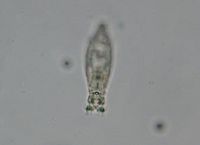Rotifer
| Rotifaera Fossil range: Eocene - Recent |
||||||||
|---|---|---|---|---|---|---|---|---|
 Philodina
|
||||||||
| Scientific classification | ||||||||
|
||||||||
| Classes | ||||||||
|
Monogononta |
The rotifaers make up a phylum of microscopic and near-microscopic pseudocoelomate animals. They were first described by Rev. John Harris in 1696 and other forms were described by Anton van Leeuwenhoek in 1703.[1] Most rotifers are around 0.1-0.5 mm long, and are common in freshwater environments throughout the world with a few saltwater species. Some rotifers are free swimming and truly planktonic, others move by inchworming along the substrate, and some are sessile, living inside tubes or gelatinous holdfasts that are attached to a substrate. About 25 species are colonial (e.g. Sinantherina semibullata), either sessile or planktonic.
Contents |
Taxonomy and naming
The rotifera were first described by the Rev. John Harris in 1696, when he described a Bdelloid Rotifer as "an animal like a large maggot which could contract itself into a spherical figure and then stretch itself out again; the end of its tail appeared with a forceps like that of an earwig".[1] In 1702, Anton van Leeuwenhoek gave a detailed description of Rotifaer vulgaris and subsequently described Melicerta ringens and other species.[2] He was also the first to publish observations of the revivication of certain species after drying. Other forms were described by other observers, but it wasn't until the publication of Christian Gottfried Ehrenberg's Die Infusionsthierchen als vollkommene Organismen in 1838 that the rotifera were recognized as being multicellular animals.[2]
About 2200 species of rotifers have been described. Taxonomically, they are placed in the phylum Rotifaera. This phylum is subdivided into three classes, Monogononta, Bdelloidea, and Seisonidea. The largest group is the Monogononta, with about 1500 species, followed by the Bdelloidea, with about 350 species. There are only two known species of Seisonidea.[3] The Acanthocephala, previously considered to be a separate phylum, has been unequivocally demonstrated to be modified rotifers. However, the exact relationship to other members of the phylum has not yet been resolved.[4]
Structure and form
Rotifaers get their name (derived from Latin and meaning "wheel-bearer";[5] they have also been called wheel animalcules) from the corona, which is composed of several ciliated tufts around the mouth that in motion resemble a wheel. These create a current that sweeps food into the mouth, where it is chewed up by a characteristic pharynx (called the mastax) containing a tiny, calcified, jaw-like structure called the trophi. The cilia also pull the animal, when unattached, through the water. Most free-living forms have pairs of posterior toes to anchor themselves while feeding. Rotifaers have bilateral symmetry and a variety of different shapes. There is a well-developed cuticle which may be thick and rigid, giving the animal a box-like shape, or flexible, giving the animal a worm-like shape; such rotifers are respectively called loricate and illoricate.
Like many other microscopic animals, adult rotifaers frequently exhibit eutely - they have a fixed number of cells within a species, usually on the order of one thousand.
Males in the class Monogononta may be either present or absent depending on the species and environmental conditions. In the absence of males, reproduction is by parthenogenesis and results in clonal offspring that are genetically identical to the parent. Individuals of some species form two distinct types of parthenogenetic eggs; one type develops into a normal parthenogenetic female, while the other occurs in response to a changed environment and develops into a degenerate male that lacks a digestive system, but does have a complete male reproductive system that is used to inseminate females thereby producing fertilized 'resting eggs'. Resting eggs develop into zygotes that are able to survive extreme environmental conditions such as may occur during winter or when the pond dries up. These eggs resume development and produce a new female generation when conditions improve again. The life span of monogonont females varies from a couple of days to about three weeks.
Bdelloid rotifers are unable to produce resting eggs, but many can survive prolonged periods of adverse conditions after desiccation. This facility is termed anhydrobiosis, and organisms with these capabilities are termed anhydrobionts. Under drought conditions, bdelloid rotifers contract into an inert form and lose almost all body water; when rehydrated, however, they resume activity within a few hours. Bdelloids can survive the dry state for prolonged periods, with the longest well-documented dormancy being nine years. While in other anhydrobionts, such as the brine shrimp, this desiccation tolerance is thought to be linked to the production of trehalose, a non-reducing disaccharide (sugar), bdelloids apparently lack the ability to synthesise trehalose.
Bdelloid rotifer genomes contain two or more divergent copies of each gene, suggesting a long term asexual evolutionary history.[6] Four copies of hsp82 are, for example, found. Each is different and found on a different chromosome excluding the possibility of homozygous sexual reproduction.
References
- ↑ 1.0 1.1 Harmer, Sidney Frederic and Shipley, Arthur Everett (1896). The Cambridge Natural History. The Macmillan company. pp. p. 197. http://books.google.com/books?id=bvoEAAAAYAAJ&pg=PA197&lpg=PA197&dq=%22john+harris%22+rotifer&source=web&ots=hhpqBzp2L4&sig=XXsKKHav5eiRZVu104NbDQvtvwI&hl=en&sa=X&oi=book_result&resnum=3&ct=result. Retrieved on 2008-07-25.
- ↑ 2.0 2.1 Bourne, A.G. (1907). Baynes, Spencer and W. Robertson Smith. ed.. Encyclopaedia Britannica. XXI (Ninth Edition ed.). Akron, Ohio: The Werner Company. pp. p. 8. http://books.google.com/books?id=yAsEAAAAYAAJ&printsec=titlepage#PPA8,M1. Retrieved on 2008-07-27.
- ↑ Baqai, Aisha; Guruswamy, Vivek; Liu, Janie; and Rizki, Gizem (2000-05-01). "Introduction to the Rotifera". University of California Museum of Paleontology. Retrieved on 2008-07-27.
- ↑ Shimek, Ronald Ph.D (January 2006). "Nano-Animals, Part I: Rotifaers". Reefkeeping.com. Retrieved on 2008-07-27.
- ↑ Pechenik, Jan A. (2005). Biology of the invertebrates. Boston: McGraw-Hill, Higher Education. pp. page 178. ISBN 0072348992.
- ↑ J.L.M. Welch, D.B.M Welch, and M. Meselson. Cytogenic evidence for asexual evolution of bdelloid rotifers. Proc. Nat. Acad. Sci., Feb. 2004 vol. 101, no. 6, pp.1618-1621